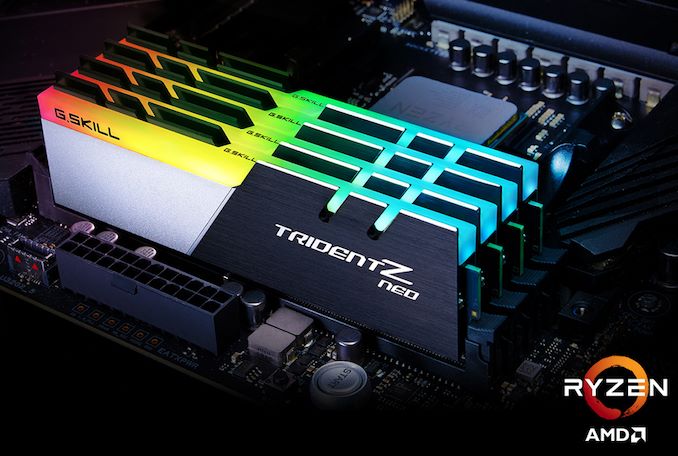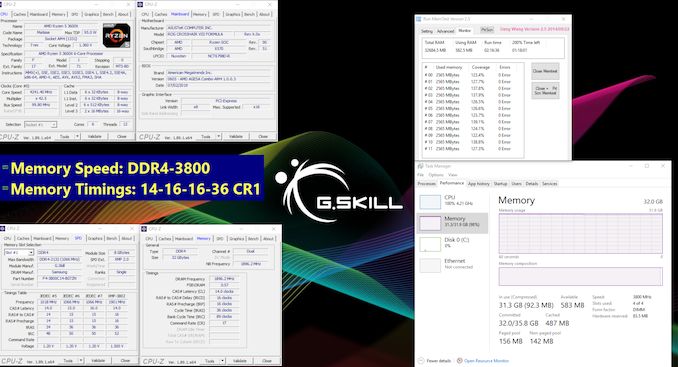G.Skill Reveals Trident Z Neo DDR4-3800 CL14 Kit for AMD Ryzen 3000
by Anton Shilov on August 1, 2019 2:00 PM EST
G.Skill has introduced its new high-end Trident Z Neo memory kits for systems based on AMD’s latest Ryzen 3000 processors. According to G.Skill, its Trident Z Neo DDR4-3800 CL14 kits reach up to 58 GB/s in measured memory bandwidth.
AMD says — and many third-party observers confirm — that its Ryzen 3000 CPUs based on the Zen 2 microarchitecture show the highest memory subsystem performance when frequencies of Infinity Fabric (fClk), memory controller (uClk), and DRAM (mClk) are equal (i.e., the fClk to mClk ratio is set at 1:1). However, far not all Ryzen processors can support high fClk clocks, so using extremely fast DDR4 memory modules (e.g., DDR4-4000+) may be detrimental in many cases. G.Skill says that its Trident Z Neo DDR4-3800 kit, which runs at CL14-16-16-36 timings at a toasty 1.5 V, offers an optimal combination of high clocks, low latency, and fClk to mClk ratio of 1:1 for AMD’s latest CPUs.
G.Skill’s Trident Z Neo DDR4-3800 CL14 8 GB modules (F4-3800C14-8GTZN) are based on Samsung’s 8 Gb B-die memory chips and use a custom PCB. The unbuffered DIMMs come with aluminum heat spreaders as well as RGB LEDs. To set up rather extreme clocks and low latencies, users will need to enable an XMP 2.0 profile.
Apart from the combination of frequency and timings, a key feature of the Trident Z Neo DDR4-3800 CL14 modules is their unprecedented voltage of 1.5 Volts, a 25% increase over DDR4 specification (1.2 Volts), that is only supported properly on high-end platforms equipped with a high-quality VRM. The module maker itself has validated its new DIMMs with ASUS ROG Crosshair VIII Formula as well as MSI MEG X570 Godlike motherboards that run AMD’s Ryzen 5 3600X or Ryzen 9 3900X CPUs.
According to G.Skill, internal tests revealed that a memory subsystem comprising of an AMD Ryzen 3000 processor as well as its Trident Z Neo DDR4-3800 CL14 modules can hit 58 GB/s, 56 GB/s, and 58 GB/s of memory bandwidth for read, write, and copy benchmarks respectively.
G.Skill will supply its Trident Z Neo DDR4-3800 CL14 8 GB DIMMs in 16 GB or 32 GB dual-channel memory kits. The kits will hit the market shortly, their MSRPs will depend on demand and supply.
Related Reading:
- G.Skill Launches Trident Neo Memory Modules for AMD Ryzen 3000 CPUs
- Patriot Unveils Viper 4 Blackout: Compatible with Ryzen 3000, Up to DDR4-4000
- The AMD 3rd Gen Ryzen Deep Dive Review: 3700X and 3900X Raising The Bar
Source: G.Skill













10 Comments
View All Comments
Dark42 - Thursday, August 1, 2019 - link
Since ZEN 2's official supported frequency is lower with 4 DIMMs than only 2 DIMMs, aren't 4 DIMM-Kits counter productive for high frequencies?lipscomb88 - Thursday, August 1, 2019 - link
There is a YouTube channel called actually hardcore overclocking that has some initial testing on zen 2 ram. So far the way to go is dual rank 2 dimm kits. Like you surmise, running with two dimms enables higher frequencies overall but per aho's testing, once the latency has been experienced to the dimm, you want as much capacity at the dimm to access. Previously I think from memory on precious zen platforms single rank ram worked much better, but the upgraded controller works well enough for dual rank to be beneficial. Because of the f clock decoupling however, you want to stick to the 1:1 range (up to the 3800 mhz of the kit in the article) where the ram speed matches the infinity fabric speed one to one. That makes this kit so good. Above 3800, the fabric clock is lowered. So the kit in the article might be the best zen 2 memory available.Blaab1 - Monday, August 5, 2019 - link
I would like to know if anyone has found a definitive review refresh on the advantages of cl(low number) vs cl(higher number) with ram nearly the same speed rating. I would also like to be refreshed on the advantages of DDR3 memory at a cl8 and DDR4 memory at a CL16. It seems to be an issue of major financial investment for gains that only the top tier buyers would appreciate.Sttm - Thursday, August 1, 2019 - link
Is RAM scaling even that great on Ryzen 3000? The two reviews I looked at showed barely any improvement from 3200 C16 to 3600 C16. With one of them even adding that that massive cache size on the 3900x was likely reducing the need for faster memory.fallaha56 - Thursday, August 1, 2019 - link
Sure but this is 3800mhz @c14, much fasterEsp good to eliminate.1% lows in games
Peter2k - Friday, August 2, 2019 - link
There is not a single test out there that compares, say 3200 CL16 with 3800 CL14Quite frankly 3600 CL16 is not very impressive at all
To me that's a "not that fast kit", at least on Intel
fallaha56 - Friday, August 2, 2019 - link
Yes there isTechpowerup have done it
You can also find similar tests for Skylake-X
The key point is that all these distributed-die / mesh type architectures like higher interconnect speeds, far more that the old single die designs ever did
GreenReaper - Friday, August 2, 2019 - link
Making one bit faster just moves the bottleneck elsewhere. But it will depend on the workload, of course - if you're doing something that fits in cache, memory speed is irrelevant. Over time it is likely to become more relevant as programs and data tend to get inexorably larger.Peter2k - Friday, August 2, 2019 - link
This is obviously a for gamer productNo work space would OC the RAM this far and up the voltage that high
Yes, Games benefit, the more CPU intense the more they do
Still not worth the upgraded cost foing from something like 3200 CL15, which is quite affordable, to maybe paying double or more the price
Obsene - Tuesday, October 15, 2019 - link
Where is this SKU? Even emailing G Skill trying to purchase/find a vendor yields nothing.